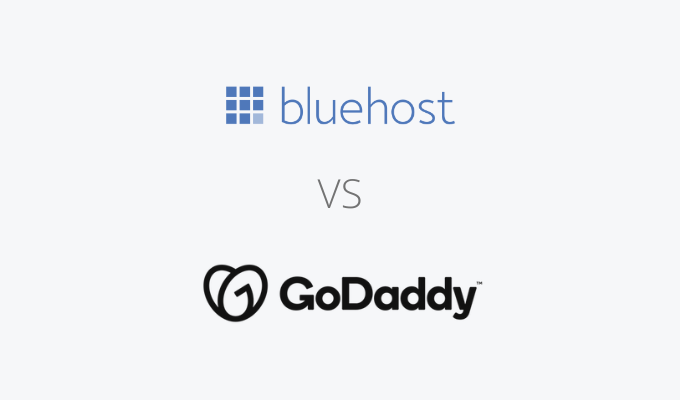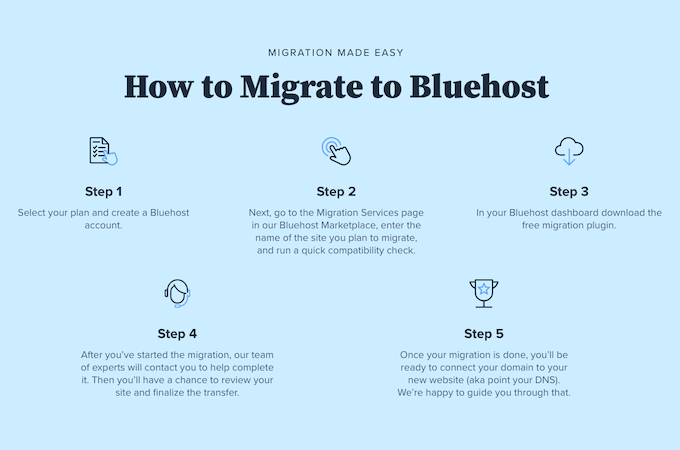Bluehost and GoDaddy both offer well-rounded, reliable website hosting services. Each of them has been around for 20 years or longer, and they’ve proven their worth when it comes to keeping business websites online.
These companies are household names and work for everyone from beginning business owners to more experienced and tech-savvy developers. Their merits come down to what you need for your business and how you want to set up your site.
Here, we’ll look at how GoDaddy and Bluehost compare to each other. Let’s start with an in-depth look at their strengths and weaknesses to help you decide which web hosting service works best for you.

Bluehost and GoDaddy Compared to the Best Web Hosting Companies
Bluehost made our top list as the best web hosting service for new WordPress websites, but GoDaddy did not. That doesn’t mean GoDaddy isn’t still a good platform, but most readers looking to build or improve their site’s performance will find other platforms more appealing. In particular, Hostinger meets user needs best with its affordability, free backups and SSL certificate, and a ton of features that make running a website simple. Save up to 80% on Hostinger plans.
- Hostinger—Best overall
- DreamHost—Best value for shared hosting
- Bluehost—Best for new WordPress websites
- HostGator—Best for simple websites
- GreenGeeks—Best eco-friendly hosting
- SiteGround—Best WordPress-certified host for speed and security
- A2 Hosting—Best for fast & reliable shared hosting
- InMotion—Best VPS hosting
- WPEngine—Best managed WordPress hosting
- Nexcess—Best for ecommerce hosting
Bluehost vs. GoDaddy High-Level Comparison
Bluehost and GoDaddy both work for people who want to get through their website set up with minimal hassle. Bluehost, however, has a lot more features for the price. Before you jump in for the feature-rich benefits, though, know that Bluehost does take more technical skill, whereas GoDaddy is made to accommodate people of all experience levels.
GoDaddy has been around a little longer than Bluehost, and aside from being easier to use, it also has slightly better performance with higher speed and traffic capacity. It keeps all the tools you need in one place, so you have quick access to everything.
Bluehost works best with WordPress, and the platform even comes as an official WordPress recommendation. Both GoDaddy and Bluehost offer free domains and backups, but Bluehost comes out ahead with a free SSL certificate, better security, and more storage. Overall, they both work for less experienced customers looking to build a professional website, but Bluehost’s features can get overwhelming at first while GoDaddy keeps its offerings simpler.
Products and Services Offered by Bluehost and GoDaddy
Bluehost and GoDaddy have similar product offerings in that they each have shared, VPS, and dedicated hosting services available. Both also offer WordPress hosting specifically, though Bluehost’s offers are more comprehensive and include more WooCommerce options than GoDaddy’s.
Because Bluehost is so prominently connected to WordPress, that’s where it stands out. Instead of a few basic WordPress plans, Bluehost has four WordPress hosting plans, three WordPress Pro packages, and two WooCommerce options. Bluehost also makes it extra simple if you’re just starting out with a new website, as they offer professional marketing services and a dedicated support team to help you succeed and grow your business.
GoDaddy offers Windows and Linux hosting plans apart from its general hosting options. These plans have features specifically designed to make it easier to navigate and use its platform, such as .NET Core and SQL Servers. It also makes VPS hosting easier with its Web Hosting Plus plans, which give you the power of a VPS server without the complicated process of learning how to use it.
Check out the complete Bluehost Review and GoDaddy Review to read more about each company’s products and services.
Company Health and Stability of Bluehost and GoDaddy
GoDaddy was founded in 1997 by Bob Parsons under the company name Jomax Technologies. Shortly after, in 1998, it began offering hosting as a service and changed its name to GoDaddy a year later. It has its headquarters in Tempe, Arizona, and is incorporated in Delaware. Currently, Aman Bhutani serves as GoDaddy’s CEO and has been with the company since 2019.
Bluehost got its start a few years later in 2003. Founded by Matt Heaton and a subsidiary of Endurance International Group, the company is headquartered in Orem, Utah. Its current CEO is Suhaib Zaheer, who has been with Endurance International Group in management positions since 2013. Bluehost itself has changed CEOs almost yearly since 2015.
GoDaddy became a publicly traded company in 2015 and is traded under the symbol GDDY on the New York Stock Exchange. GoDaddy has had some rocky moments in its history, including a $531 million loss between 2009 and 2014 before it became a publicly traded company. Since then, its financial health has improved, and it has over 62 million domains. Endurance International Group trades under the symbol EIGI on the NASDAQ.
Both GoDaddy and Bluehost have plenty of stability. They each rank among the most widely used website hosting companies, and new customers don’t need to worry about either of them disappearing.
Bluehost vs. GoDaddy Pricing Comparison
GoDaddy is more expensive than Bluehost, but both options have their upsides and downsides. Neither has a free trial, which makes it difficult to know whether the product will work well for you before you commit to it.
Bluehost’s Basic plan lets you create one site with standard CPU performance and 10 GB storage. The plan gives you a limited number of databases and domains. You don’t get any extras with this package, which means no marketing features or add-ons that come with the more expensive plans. As you upgrade, you can take advantage of unlimited websites and domains, as well as Google Ads, spam experts, automated backups, and premium SSL certificates.
GoDaddy’s Economy plan has some features like Bluehost’s in that you get one website with a limited number of databases, unmetered bandwidth, and a free domain for a year. This plan also offers free one-click WordPress installation, 25GB storage, and two free Microsoft 365 mailboxes for the first year. Its more expensive tiers upgrade your storage, mailboxes, processing power, and databases.
Pricing Structures of Bluehost and GoDaddy
Bluehost and GoDaddy both bill monthly. With both companies, you can opt to pay for a one-year term or for three years at a discounted rate. Each company also offers varying rates based on whether you choose shared, VPS, or dedicated hosting packages.
Bluehost starts at a heavily discounted introductory price of $2.75 per month for shared hosting, but after the first year, it bumps up to $9.99 per month. All of its plans are like this, so make sure you check on future pricing before you buy. For shared hosting, you get optimized CPU performance starting at $13.95 per month with automated backups and positive SSL, 100GB website storage, and spam experts on two domains.
GoDaddy’s introductory prices are lower than its future renewal costs, but those renewal fees are cheaper than Bluehost’s. The company’s Maximum shared hosting package offers boosted processing and performance for up to 50 websites at $19.99 for a three-year term before renewing at $24.99 per month. If you don’t need quite as much as what Maximum offers, the Ultimate package comes recommended for high-traffic websites at $12.99 per month to start.
Cost Comparison of Bluehost and GoDaddy
For a basic, economical web hosting package, Bluehost has the better deal. Its introductory pricing lets you try it for a low cost, and although GoDaddy looks cheaper in the long run, the company has a lot of upsells you’ll need to make your site work optimally. That said, if a fast, low-effort setup is your priority, GoDaddy may be worth it.
Since so many businesses use WordPress websites, Bluehost is a better option there, too. Although GoDaddy does offer WordPress hosting and one-click installation, Bluehost comes recommended by WordPress, and most users seem happy with how it works and what it offers. Bluehost tacks on several free features, too, and at a starting price of $2.75 per month (as opposed to GoDaddy’s $5.99), it’s hard to find a hosting service that gives you as much as this one.
Trials and Guarantees for Bluehost and GoDaddy
Bluehost offers a 30-day free trial and a money-back guarantee, so if you try it and find it doesn’t work for you, then you haven’t lost anything. The guarantee only applies to their hosting plans, so if you purchase add-ons, you’re out of luck. Bluehost also offers some free features that other companies—including GoDaddy—charge for, like a free SSL and CDN.
GoDaddy carries a little more risk there because it doesn’t offer a trial or money-back guarantee unless you haven’t yet activated your plan. However, it does offer free trials for certain features and tools, like its website builder.
In terms of trials and guarantees, Bluehost has more to offer thanks to its 30-day trial. Beyond that, neither of them has many options for testing their service.
Bluehost vs. GoDaddy Core Criteria Comparison
Overall, I consider Bluehost the stronger option of the two for its comprehensive features and affordability. It performs well with great uptime, and it has plenty of tools to make hosting easy, even for beginners. Above all, it suits WordPress websites best, so if you’ve already got a WP website you want to migrate, Bluehost is a no-brainer.
GoDaddy works better if you’re starting from the bottom up with a platform other than WordPress. Its website builder is easy to navigate and has all your tools in one spot. Plus, if you plan to grow your business, GoDaddy is great for high traffic with performance that rivals Bluehost.
See how Bluehost and GoDaddy compare to their competitors when you check out our top picks for website hosting services.
Uptime—Bluehost Wins

Uptime is the most important factor in deciding which web hosting service works best for you. It shows how often and how long your site becomes unavailable for visitors, and you want that time to be as little as possible. A site that goes down all the time will deter visitors, which means they then choose your competitors, no matter how good your products and services are.
Bluehost rarely goes down and has uptime around 99.99% compared to slightly lower rates with GoDaddy. The company typically resolves any issues within 15 minutes, so even if it does go down, it’s only for a short time.
Bluehost doesn’t have an uptime guarantee like GoDaddy (which promises 99.9% uptime), but it proves itself even without one. One of the most consistently cited reasons people stick with Bluehost is its uptime, which tells you how valuable it is.
Website Speed—GoDaddy Wins

You have three seconds to make an impression on your website visitors. If your website takes longer than that to load, you risk losing potential customers. While website speed doesn’t rely solely on your hosting service, it is a major part of the equation.
Even on its slow days, it comes in roughly equal to SiteGround, which made our top list for its speed. While any host’s speeds come with some variation, GoDaddy still came in well below the three-second mark, showing loading speeds under one second.
GoDaddy isn’t the fastest web hosting service around, but it’s slightly faster than Bluehost. It also doesn’t delay in fully loading the page, which helps keeps visitors on your site.
Customer Support—Bluehost Wins

If something goes wrong with your website, you want to know that someone is there to help. Good customer support can mean the difference between getting your site back online fast and losing business. Plus, knowing that a representative will get back to you gives you peace of mind.
When you contact Bluehost for help with your hosting service, a representative responds promptly—often within seconds. Bluehost has 24/7 phone support, and you can also contact them by chat and email. When compared to GoDaddy, GoDaddy’s support sometimes takes up to half an hour to respond to the company’s live chat, and the quality of the service varies.
Bluehost also has plenty of self-help resources, if you prefer to try tackling the problem on your own first. They have several guides and tutorials you can follow, as well as troubleshooting articles, and you can easily search all of them to find what you need.
Traffic Volume—GoDaddy Wins

Having a web hosting service that can handle a large number of visitors at once makes it much easier to scale your business. A host with a high traffic capacity means your site is less likely to crash and become unavailable for visitors. As a result, customers see your business as reliable and are more likely to return.
Both GoDaddy and Bluehost can handle high traffic volumes, but most people find that GoDaddy has a slightly higher capacity. GoDaddy maintains its speed and performance with more visitors, even on its less advanced plans.
Bluehost handles a decent amount of traffic, but it’s more likely to lag under high-volume stress. That said, it doesn’t go down, but the lag may deter some visitors if it gets too close to or exceeds that three-second mark.
Migration Features—Bluehost Wins

Migrating your existing website from your current host to another is much more convenient than building a new one from scratch. With migration, you can keep your current site functioning, so you don’t lose time or customers waiting to get a new one up and running.
Some web hosting services offer free website migration, but not Bluehost or GoDaddy. Bluehost charges $149.99 for its migration service, which is pretty steep. However, they do offer expedited service and their experts do the whole thing for you. They’ll transfer up to five websites and 20 email accounts, and they company’s website says they pride themselves on performing seamless migrations.
GoDaddy, on the other hand, doesn’t specify the cost of its migration services online, but it is included in one of the many things the host makes you pay extra for. Plus, unlike Bluehost’s speedy service, GoDaddy makes you wait up to 10 days to complete the process.
Managed Hosting—Bluehost Wins

Managed hosting takes one more task off your plate when it comes to maintaining your website. Most of the time, a host will give you a login so that you can go in, configure your server, and install the software that will make your site run. Sometimes, this involves coding, and it can be too complicated and overwhelming for some users.
Bluehost has managed servers with all of its packages. It handles the heavy lifting of the setup for you so that you can get back to business fast. Managed hosting is also optimal for WordPress sites, which is Bluehost’s specialty, so having this feature only makes it easier to run your site with more speed and security.
GoDaddy does offer some managed hosting plans, but not with its shared packages. Instead, it leaves you to do what most other hosts do and set things up yourself. That isn’t always a bad thing, though, as some users prefer to have that level of control over their server. For other people, it’s nice to have the option for managed hosting if they need it.
Final Verdict—Bluehost Wins
Our research puts Bluehost slightly ahead of GoDaddy in terms of overall features, usability, and pricing. Its reliable platform gives you everything you need to set up your hosting service with a free domain, CDN, and SSL certificate, as well as a generous introductory offer. With reliable uptime and speed, Bluehost works well whether you’re building your first website or are a seasoned web developer.
GoDaddy works best if you want a simple setup with all your tools in one place. Its performance and high traffic capacity make it a great option for growing businesses.
To learn more about how GoDaddy and Bluehost compare to top competitors, check out our top picks for web hosting services.
